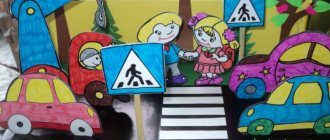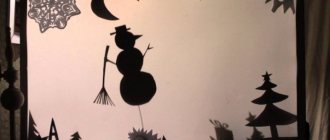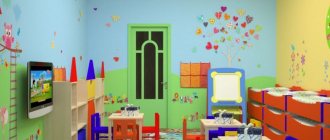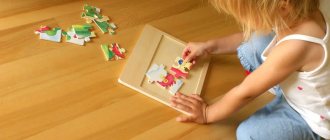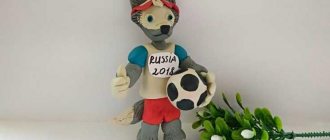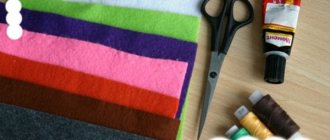Cardboard theater
An ordinary cardboard shoe box will become magical if you decorate it with fabric, secure it in the form of a curtain, and place a picture based on the plot of a fairy tale on the backdrop. You can make the decorations yourself: print or draw a chair, a chair, a table, a magic castle or a hut.
Cut a hole in the bottom of the box and attach ribbon to the side walls. Such a theater can be hung on your neck, then it will be very convenient to show scenes from figures attached to wooden skewers.
The characters are simply cut out of paper, and the manufacturing process itself is an act of improvised theater. The child can try himself as a costume designer and artist, choosing characters and scenery or a director, changing the plot at will.
Make little characters to put on your fingers. This is a very fun activity for a child.
Paper finger theater: benefits for child development
Speech development
As children interact with and play with the puppets, they organize their thoughts and improve their language.
Children naturally develop sentence structure and use active vocabulary to express their points of view. Their interactions often reflect their experiences and knowledge of the real world, giving children the opportunity to better understand this information through play.
Development of imagination
Dolls are the main toy for role-playing games and allow children to improve their creative imagination.
When a child plays, stories and characters with personalities emerge. They may feel happy, sad, or sassy and stupid.
With animal dolls, kids can simply waste their time meowing like a cat and mooing like a cow. This is, of course, good too!
The process of finger play offers a leap forward for their creativity, and as role play progresses, children will develop their language and storytelling skills without even realizing it.
Development of fine motor skills
When children manipulate finger puppets to make them move, changing their position from finger to finger, children's fine motor skills are involved.
The act of playing with dolls is also beneficial for hand-eye coordination.
All these useful skills are developed while playing with finger puppets. And if a child helps you make a finger theater out of paper with your own hands, he improves:
- cutting and gluing skills,
- motor skills,
- graphomotor skills
- creativity,
- perseverance.
Shadow play. How to do it quickly and easily
Step 1. Setting the stage
Take a medium sized box. Preferably 10-15 cm wide, but a box of a different width will do. You will need a ruler, pencil, stapler, scissors. We separate the box from one long side. You should get a large rectangle, one plane of which is flat without bends. ON this side we measure 5 cm from the edge. Draw the frame of the screen and cut it out. We fasten it with a stapler at the corners so that we get an L-shaped structure with a vertical future screen. Cut off the excess.
We measure out the paper that will cover the screen with an allowance for gluing. The top of the screen can be secured with a stapler. Apply paper glue to the remaining sides.
Step 2. Create characters
You will need a pencil, cardboard, scissors, a stapler, and straws for drinks. We draw characters and cut them out. In addition to action heroes, you can make the sun and clouds, birds and trees, houses and castles. Using a stapler, we attach the figures to the straw.
Step 3. Play the play
We learn a fairy tale, install a table lamp behind the screen, and play the fairy tale. Don't forget about sound effects.
Tabletop theater at home
So, what should you choose for home education and development for children from one to three years old? Of course, any activity at this age should be based on play .
Do you have an active child and dream of a quiet activity together? Then a tabletop theater can help you! It turns out that making it with your own hands is not so difficult. A puppet theater for kids can be made from many materials. The most difficult and labor-intensive option is to sew dolls or cut out figures from wood. The simplest and most suitable for a busy mother is to print from paper or cardboard at home.
Where to start if you want to make a paper theater for your child with your own hands? First of all, prepare your materials. You will definitely need:
- color printer;
- thickened paper or cardboard;
- scissors;
- glue;
- scotch;
- templates for crafts in electronic form or your own drawing.
DIY puppet theater
To create a theater you will need a box with sides up to 10 cm high. A cookie box will do. We cover the box with colored paper using double-sided tape.
Let's start creating the curtain. The width of the curtain can be from 3 to 5 cm, the length is the size of the box. On a sheet of red velvet paper, measure the width of the curtain twice and cut off a strip. Then fold it in half, draw the outline of the curtains and cut it out. We cut the finished part along the central fold. We draw folds that imitate the drapery of a curtain with a felt-tip pen. Glue the curtain along the edges of the box.
Then we make a lambrequin. Measure 2 cm in width, draw an outline and cut it out. We measure the length of the lambrequin using the box. We cut it out, draw draperies, and glue it on top of the curtain.
Using a stationery knife, we make a slit up to 1 cm wide on the side of the box, through which the decorations will change.
Backdrops for decorations can be printed or drawn by hand. The size of the pictures must be adjusted to the internal size of the box. If the backgrounds are composed during the course of a fairy tale or play, their change will create the impression of a real theatrical action.
To make the characters you will need juice straws, double-sided tape and printed images of the characters. We fix the cut out figures on the tubes. All is ready! The show can begin.
Hand puppets for home theater
Felt doll
Will need
- Sketch of a puppet toy.
- Two sheets of felt, A4 size.
- Small pieces of colored felt.
- Thread and needle.
- Glue gun.
- A sheet of thin cardboard.
We start work by creating a pattern. To do this, draw the sketch onto a sheet of cardboard and cut it out. You will get the main pattern of the figure and individual small details: eyes, muzzle, palms, tummy, ears. The number of details depends on the choice of sketch of the puppet hero.
Then we transfer all the details onto felt. We select the color scheme according to our taste or the content of the fairy tale. The hare can be white, gray or pink, and the fox yellow or orange. If you are doing a craft with your child, let him choose what color the characters in your play will be.
We cut out the parts and pre-assemble the toy, placing all the parts in the places where they should be. If the result is satisfactory, we begin the final assembly. First, we make one main piece out of felt. We sew on all the parts that can be sewn. We sew with a buttonhole stitch. We glue small parts with a glue gun. We put all the parts together in accordance with the sketch.
If the toy has ears, we attach them last. To do this, we fold the two main parts with the right sides facing inward. We apply the ears in such a way that the edges of the part coincide with the edges of other parts, and the tips of the ears look inward. We sew all the details along the edge with a buttonhole stitch and turn the toy inside out. The glove puppet is ready, and the ears will stick out funny on the top of the head.
Sock puppet
Original dolls are made from ordinary children's socks.
To make it you will need a sock, cardboard, a small skein of thick thread or yarn, pieces of fabric for the mouth, sewing thread and buttons, and a glue gun. You can take a sock in a plain color or with a pattern, polka dots or stripes - all this will create the image of a future toy.
We make a blank for the mouth from cardboard. To do this, fold a cardboard rectangle 7 cm wide and 20 cm long in half. We round the corners along the width. From the fabric for the inside of the mouth we cut out a blank according to this template.
Trim the toe of the sock. We cut off the edges along the edge of the workpiece. Glue the cardboard blank inside the sock using a glue gun. At the same time, we fold the edges of the fabric onto the cardboard. Glue the fabric interior on top.
Making a hairstyle for the puppet. Take thread or yarn and wrap it around your hand several times. Tie in the middle and cut the ends. If you spread your fingers wide, you will get a long hairstyle. Sew the hairstyle to the sock.
Let's make eyes. We take two buttons and sew them to the sock, overlapping one on top of the other. You can use ready-made eyes or ones drawn and cut out of cardboard. You can complement the image with any details, make eyes from balls of cotton wool or add decorative elements.
Non-traditional types of theater
In addition to the usual materials for puppet theaters, alternative types can be used.
These can include plastic and wooden spoons. Images of characters are drawn or attached to them. When painting on plastic, you should use acrylic paint. If you have to paint with gouache, it is mixed with a small amount of PVA glue.
Interesting options are made from yogurt jars and plastic bottles. They are covered with colored paper, images of characters are attached and fragments of scenery are added. The results are voluminous mini-stories. Such figures do not require additional decorations and develop children's imagination.
Playing theater is a useful and interesting activity. It improves memory and develops oratory skills. The child learns to retell the text, highlight the main points, not be afraid of public speaking, and parents have the opportunity to discern the child’s talents.
Work in the theater corner
Activities related to theatrical performances in kindergarten are implemented by several types of play activities:
- Director's games. In them, the child only leads the doll, conveying the image of the character with intonation and some other techniques. The possibilities of pantomime here are also very limited, because the toy is almost static (puppets on canes, puppets).
- Dramatizations. The baby plays the role himself, without resorting to the mediation of dolls. The young actor is able to actively use intonation, facial expressions, movements and gestures to enter into the character of the hero.
- Dramatizations with bibabo, finger, floor or scarf puppets. The baby acts for the character, giving him his voice. The work is carried out from behind a screen or with a character in hand.
Working with floor dolls is very difficult, but exciting for children - you cannot use facial expressions
- Improvisation. Children act out themes, not plots. Such theatrical activity requires almost no preparatory work, but is the most complex type of game. Various theatrical props can be used for improvisation.
The theater corner, which has everything necessary for the relevant activity, allows you to create a comfortable environment in the group for the development of the creative abilities of students. Theatricalization is a special area of the educational program for preschool institutions, because it gives children the opportunity not only to explore the world around them, but also to learn to live in harmony with it. In addition, theatrical performances help children become more self-confident, which is also important for their personal growth - which means that a kindergarten cannot be without a theater corner.
